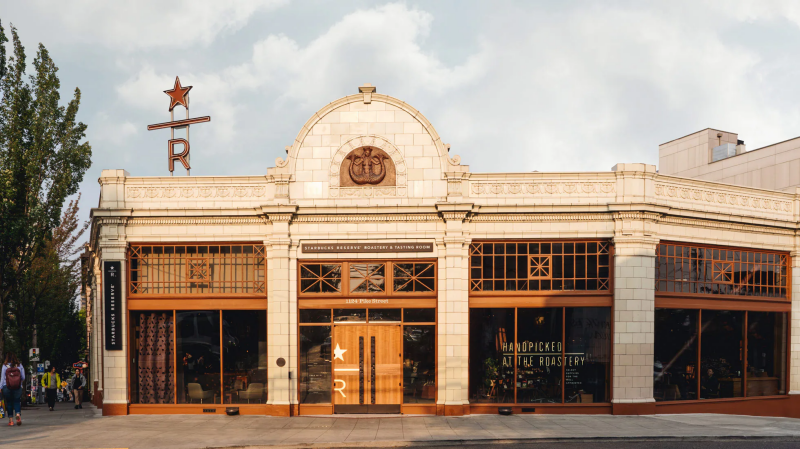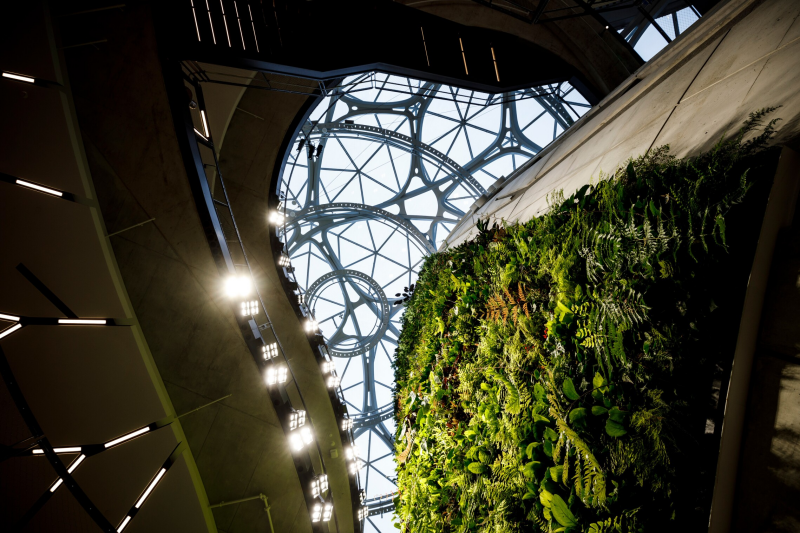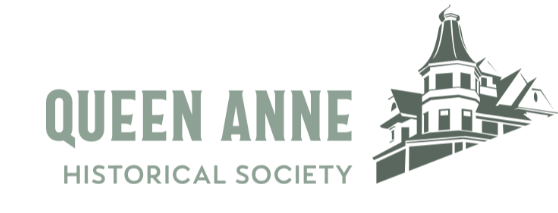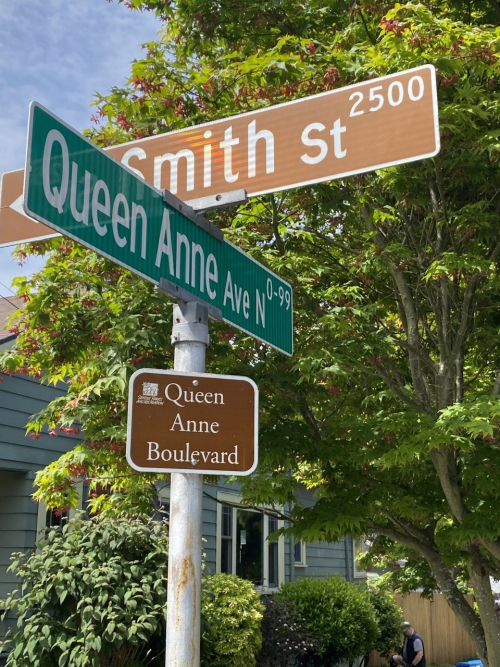Seattle Roastery
In December 2014, they unveiled their first Starbucks Reserve Roastery in Seattle’s lively Capitol Hill neighborhood. Just nine blocks from the original Starbucks® store at Pike Place, this Roastery serves as an immersive and striking tribute to their passion for coffee.
South Lake Union
-
South Lake Union (SLU) is one of Seattle’s most dynamic and rapidly growing neighborhoods, located just north of downtown and centered around the southern edge of Lake Union. Known for its transformation from an industrial area into a hub for tech companies, biotechnology firms, and vibrant urban living, SLU has become a focal point for innovation and development in Seattle. It’s home to major companies like Amazon, numerous research institutions, and a variety of modern residential and commercial spaces.
Historical Background of South Lake Union
Early Days: In the late 1800s and early 1900s, South Lake Union was primarily an industrial area, home to lumber mills, manufacturing plants, and warehouses due to its proximity to Lake Union, which facilitated easy transport of goods. It was also the location of the city’s first streetcar lines.
Post-Industrial Decline: By the mid-20th century, the area saw a decline as industrial activities diminished, leaving much of the neighborhood underdeveloped and underutilized. For decades, it was a mix of light industrial spaces and parking lots, not yet a focal point of urban life in Seattle.
Paul Allen’s Vision: South Lake Union’s transformation began in the late 1990s when Microsoft co-founder Paul Allen and his development company, Vulcan Real Estate, began acquiring large parcels of land in the area. Allen envisioned turning the neighborhood into a center for innovation, science, and technology. Over the next two decades, SLU was redeveloped into a modern urban hub.
Key Features and Attractions of South Lake Union
Tech Hub:
Amazon Headquarters: The most significant development in SLU has been the establishment of Amazon’s global headquarters, which spans several blocks in the heart of the neighborhood. Amazon’s presence has reshaped the area, attracting thousands of workers and spurring a real estate boom. The company’s high-rise offices, known as Amazon’s Spheres, feature massive glass domes filled with plant life, serving as both an office space and an urban greenhouse.
Biotech and Research: In addition to Amazon, SLU is home to numerous biotech firms and research institutions, including the Fred Hutchinson Cancer Research Center, UW Medicine, and Seattle Children’s Research Institute. This has made the neighborhood a key part of Seattle’s biotechnology and medical research sectors.
Residential and Urban Living:
Modern Apartments and Condos: South Lake Union has experienced a surge in residential construction, with modern apartments, condominiums, and townhomes offering urban living options for young professionals, many of whom work in the tech and research industries nearby.
Walkability and Public Transit: SLU is a highly walkable neighborhood, with easy access to dining, retail, and outdoor spaces. It’s also well-connected by public transportation, including the South Lake Union Streetcar, which runs from the heart of the neighborhood to downtown Seattle. The Link Light Rail and bus routes also make commuting convenient.
Dining and Retail:
Restaurant Scene: SLU boasts a diverse dining scene, with restaurants catering to the tech and urban crowd. Popular spots include Duke’s Seafood for waterfront dining, Portage Bay Café for brunch, and Cactus for Mexican-inspired fare. New cafes, food trucks, and fine dining establishments continue to pop up as the area grows.
Retail: As the neighborhood has developed, retail options have expanded, with everything from boutique stores to larger retail chains. Whole Foods and other grocery stores serve the growing population, and Amazon’s brick-and-mortar stores, such as Amazon Go, showcase the company’s cashierless technology.
Outdoor Spaces and Recreation:
Lake Union Park: Located at the southern tip of Lake Union, this park is a central gathering space for SLU residents and visitors. It offers green spaces, walking paths, picnic areas, and waterfront access, making it a great spot for outdoor activities. You can also rent kayaks or paddleboards to explore the lake, or hop on a seaplane for scenic flights.
Museum of History & Industry (MOHAI): Adjacent to Lake Union Park, MOHAI is a popular museum that explores Seattle’s history and innovation. It offers interactive exhibits on the city’s maritime history, tech industry, and the people who shaped Seattle’s growth.
Cheshiahud Lake Union Loop: This 6-mile trail circles Lake Union and passes through SLU, providing scenic views of the lake and access to parks and waterfront attractions. It’s popular with joggers, walkers, and cyclists.
Cultural and Community Events:
Seafair: Every summer, Lake Union hosts Seafair, a large festival that includes hydroplane races, air shows, and parades. The highlight is often the Blue Angels performing over the lake, drawing thousands of spectators.
South Lake Union Block Party: This annual neighborhood festival brings the community together for live music, food trucks, and entertainment. It’s a showcase of SLU’s urban culture and growth.
Farmers Markets: SLU hosts regular farmers markets where local vendors offer fresh produce, artisan goods, and food. The markets are popular with residents and workers alike, offering a chance to experience local flavors and crafts.
Sustainability and Innovation:
SLU is at the forefront of sustainable urban development. Many of the new buildings in the neighborhood are LEED-certified, incorporating green building practices such as energy efficiency, water conservation, and environmentally-friendly construction materials.
The Bullitt Center, located just outside the SLU neighborhood, is considered one of the greenest commercial buildings in the world, designed to be energy-neutral and environmentally sustainable.
Transportation and Accessibility:
South Lake Union Streetcar: This streetcar line connects SLU to downtown Seattle, making it easy for residents, workers, and visitors to move between the neighborhood and other parts of the city.
Bike Lanes: SLU is very bike-friendly, with dedicated bike lanes connecting the neighborhood to Seattle’s broader cycling network. The Cheshiahud Loop and other bike paths make cycling a popular option for commuting and recreation.
Light Rail: The Westlake Station, at the southern edge of SLU, provides access to the Link Light Rail system, connecting the neighborhood to downtown, the University of Washington, Capitol Hill, and Sea-Tac Airport.
Challenges Facing South Lake Union
Gentrification and Rising Costs: As SLU has developed into a high-tech hub, the cost of living has risen dramatically. Housing prices and rent have increased, making it difficult for lower-income residents and long-time Seattleites to afford to live in the neighborhood. This has led to concerns about gentrification and the displacement of some communities.
Traffic and Congestion: The rapid growth in population and businesses in SLU has contributed to traffic congestion, especially during peak hours. While public transportation helps alleviate some of the burden, the increase in cars, bikes, and pedestrians can create challenges for the neighborhood’s infrastructure.
Future Development
South Lake Union is expected to continue growing, with more residential, commercial, and office developments planned for the future. Amazon's expansion and the influx of tech companies will continue to drive demand for housing, office space, and amenities. Additionally, ongoing efforts to enhance public transit, green spaces, and community infrastructure will shape the neighborhood’s future as a central hub for innovation and urban living in Seattle.
Conclusion
South Lake Union is one of Seattle’s most rapidly changing and innovative neighborhoods. Once an industrial district, it has transformed into a bustling hub for technology, biotech, and urban living. With its high-rise offices, modern apartments, vibrant dining scene, and proximity to Lake Union, SLU offers a dynamic blend of work and play. However, the neighborhood also faces challenges related to gentrification, traffic, and the balance between development and affordability. As the neighborhood continues to evolve, it remains at the heart of Seattle’s tech-driven economy and urban revitalization efforts.
Amazon Headquarters
The Spheres offer a unique environment designed to inspire fresh thinking and innovative work, all while being immersed in the restorative presence of nature.
Born from a bold reimagining of the modern workplace, The Spheres address what’s often lacking in urban offices—a direct connection to the natural world. They house over 40,000 plants from cloud forest regions spanning more than 30 countries, creating a living, breathing sanctuary in the heart of the city.
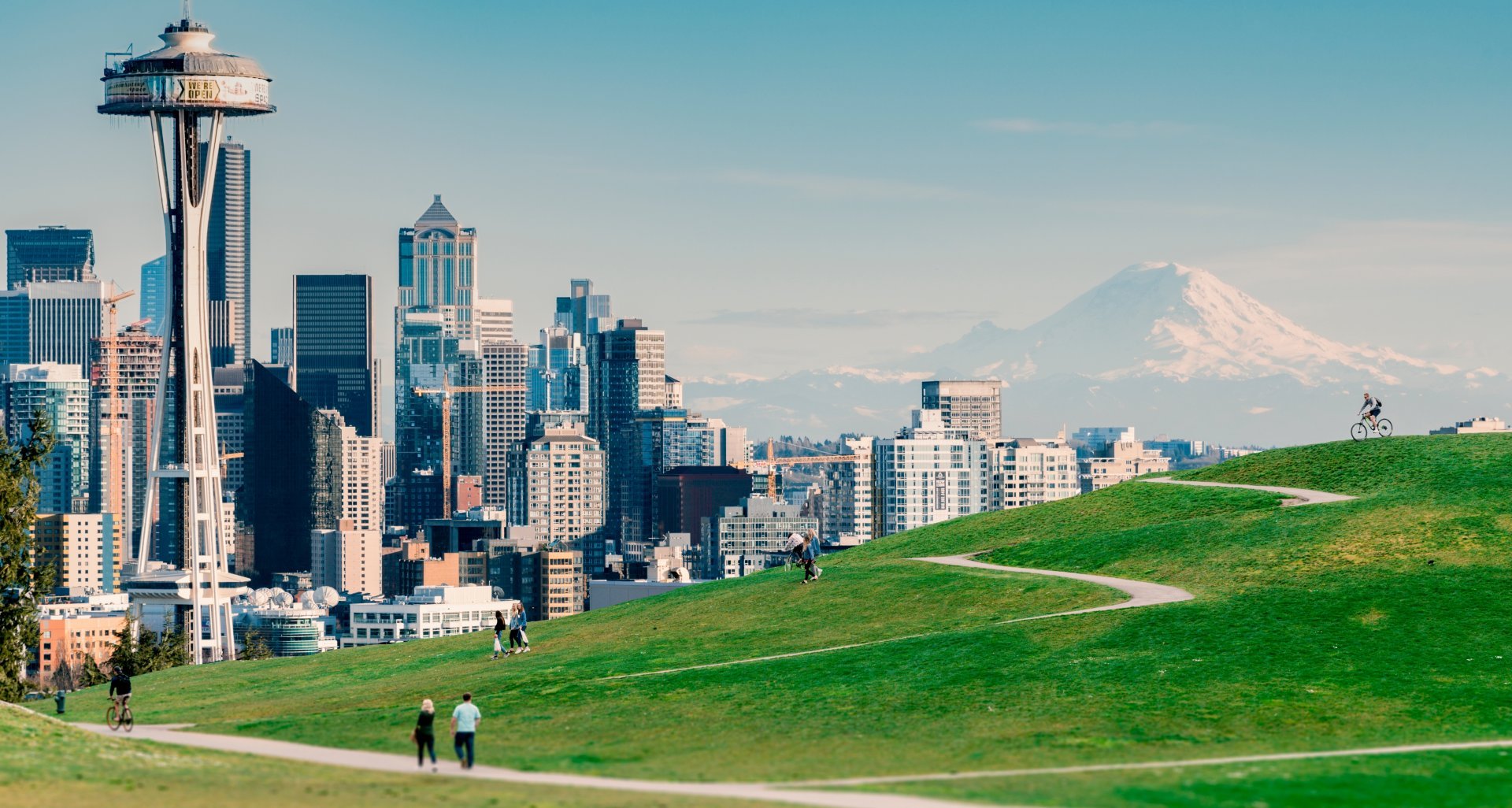
LSU Guide
Capital Hill
-
Capitol Hill is one of Seattle’s most vibrant, eclectic, and historically significant neighborhoods, located just east of downtown. Known for its arts and music scene, LGBTQ+ community, nightlife, and political activism, Capitol Hill is a cultural hub where diversity, creativity, and progressive values flourish. It’s a densely populated urban area with tree-lined streets, historic architecture, and a mix of residential, commercial, and entertainment spaces.
Historical Background of Capitol Hill
Origins and Early Development: Capitol Hill was initially developed in the late 1800s as a residential area. The neighborhood’s name has long been debated, with one story suggesting it was intended to be the location of Washington State’s capital, while another attributes it to developer James A. Moore, who reportedly wanted to give the area a prestigious name to attract residents. Early on, it became home to wealthy Seattleites who built large, stately homes, many of which are still present today.
20th Century Transformation: By the mid-20th century, Capitol Hill had shifted from being solely a residential neighborhood to becoming a center for arts, music, and progressive political movements. The 1960s and 1970s saw the rise of the LGBTQ+ community in the neighborhood, and Capitol Hill became a hub for activism, civil rights, and countercultural movements.
LGBTQ+ Community and Activism: Capitol Hill has long been the epicenter of Seattle's LGBTQ+ community. In the 1980s and 1990s, it became known as a safe space for LGBTQ+ individuals and businesses, including bars, clubs, and advocacy organizations. The annual Seattle Pride Parade often passes through or ends in Capitol Hill, underscoring its historical significance to the city’s LGBTQ+ community.
Key Features and Attractions of Capitol Hill
Arts, Culture, and Music Scene:
Music Venues: Capitol Hill has been central to Seattle’s music scene, particularly during the grunge era of the 1990s. Famous venues like Neumos, The Crocodile, and Chop Suey regularly host local and touring bands, while smaller clubs, bars, and lounges also offer live performances across a variety of genres. The neighborhood’s connection to music and art is deeply ingrained, and it remains a popular spot for discovering new talent.
Capitol Hill Block Party: This annual summer music festival is one of the neighborhood’s biggest events, featuring a mix of indie, electronic, hip-hop, and rock performances. It takes over several blocks of Capitol Hill with multiple stages, drawing thousands of music fans to the area for a weekend of performances and community celebration.
Theater and Art: Capitol Hill is home to several theaters and art galleries, such as the Annex Theatre, Northwest Film Forum, and 12th Avenue Arts. These spaces offer performances, independent films, and exhibitions that reflect the neighborhood’s creative energy.
Nightlife and Dining:
Nightlife: Capitol Hill is renowned for its vibrant nightlife, with a wide variety of bars, clubs, and lounges catering to different tastes and communities. The neighborhood’s LGBTQ+ bars and clubs, like R Place, Queer/Bar, and Cuff Complex, are popular destinations for locals and visitors. The area around Pike/Pine streets is particularly lively, filled with cocktail bars, craft breweries, and dance clubs that stay open late into the night.
Dining Scene: Capitol Hill’s diverse food scene reflects its eclectic spirit, offering everything from upscale restaurants to food trucks and casual eateries. Some well-known spots include Momiji (sushi), Spinasse (Italian), and Stateside (Vietnamese-French fusion). The neighborhood also has a strong café culture, with places like Victrola Coffee Roasters and Espresso Vivace being local favorites.
Parks and Outdoor Spaces:
Volunteer Park: One of the largest and most iconic parks in the neighborhood, Volunteer Park is a popular spot for locals to relax and enjoy nature. It features the Volunteer Park Conservatory, a historic greenhouse with exotic plants, and the Seattle Asian Art Museum, which recently underwent a major renovation. The park also offers walking paths, picnic areas, and views of downtown Seattle from the Volunteer Park Water Tower.
Cal Anderson Park: Named after Cal Anderson, Washington State's first openly gay legislator, this park is located at the heart of Capitol Hill. It’s a gathering place for events, protests, and community activities, and features a sports field, playground, and a reflecting pool. The park played a central role in the Capitol Hill Organized Protest (CHOP) during the 2020 Black Lives Matter protests.
Louisa Boren Park: Located on the northeastern edge of Capitol Hill, this park offers sweeping views of Lake Washington, the Cascades, and Bellevue, making it a quieter, scenic retreat within the neighborhood.
Architecture and Historic Districts:
Historic Homes and Buildings: Capitol Hill is known for its historic architecture, with beautiful early 20th-century mansions and homes in styles such as Colonial Revival, Tudor, and Craftsman. Some areas, like the Harvard-Belmont Historic District, showcase Seattle’s early wealth and are home to well-preserved residences and landmarks.
Eclectic Mix of Modern and Historic: In recent years, Capitol Hill has seen a surge in new development, particularly apartment buildings, creating an interesting blend of old and new architecture. The tension between preserving historic buildings and accommodating Seattle’s growing population is a point of local debate.
Progressive Politics and Activism:
Capitol Hill has a long history of political activism, particularly regarding LGBTQ+ rights, racial justice, and other progressive causes. It’s often a gathering place for protests and demonstrations. During the summer of 2020, it was the epicenter of the Capitol Hill Occupied Protest (CHOP), which arose from the Black Lives Matter movement after the killing of George Floyd. The CHOP zone became a symbol of the national protest movement for racial justice and police reform, though it eventually disbanded.
The neighborhood’s progressive values are also reflected in its local politics, with many residents advocating for affordable housing, police reform, and environmental sustainability.
Education and Institutions:
Seattle Central College: Located on Broadway, Seattle Central College is a key educational institution in the neighborhood, offering a wide range of programs and contributing to Capitol Hill’s youthful, academic atmosphere.
Cornish College of the Arts: A private art college focused on performing and visual arts, Cornish College adds to the creative culture of the neighborhood. It’s known for producing graduates who go on to work in theater, music, dance, and other artistic fields.
Shopping and Local Businesses:
Capitol Hill’s shopping scene is diverse, with a mix of independent boutiques, record stores, and vintage shops. Elliott Bay Book Company, one of Seattle’s most beloved independent bookstores, is located in the neighborhood and is a gathering place for literary events and author readings.
Local Boutiques: The neighborhood is home to numerous small, locally-owned businesses, from fashion boutiques and record stores to specialty food markets and artisanal shops, many of which reflect the neighborhood’s quirky and creative spirit.
Challenges Facing Capitol Hill
Gentrification: Like much of Seattle, Capitol Hill has experienced gentrification in recent years. Rising rents and housing costs have made it difficult for some long-time residents, artists, and small businesses to remain in the area, sparking debates about preserving the neighborhood’s character and diversity.
Homelessness: Capitol Hill, like many urban neighborhoods in Seattle, struggles with homelessness. The proximity to downtown and other services, combined with the neighborhood’s open spaces, has made it a visible issue that local activists and policymakers are working to address.
Future of Capitol Hill
Capitol Hill continues to evolve as Seattle grows. New development projects, particularly along the Light Rail corridor, will shape the neighborhood’s future. Efforts to maintain its artistic, cultural, and LGBTQ+ heritage are ongoing, even as the influx of new residents and businesses brings change.
Conclusion
Capitol Hill is one of Seattle’s most dynamic and culturally rich neighborhoods. With its blend of historic architecture, cutting-edge arts, LGBTQ+ pride, nightlife, and progressive politics, it stands as a symbol of the city’s creative and activist spirit. While it faces challenges related to gentrification and homelessness, Capitol Hill remains a thriving and inclusive community that continues to attract a diverse array of residents, visitors, and businesses. Whether exploring its vibrant music scene, dining at its eclectic restaurants, or strolling through its parks, Capitol Hill offers a quintessential Seattle experience.

Queen Anne
-
Queen Anne is one of Seattle’s most iconic and picturesque neighborhoods, known for its hilltop location, stunning views of the city and Puget Sound, and historic architecture. Divided into Upper Queen Anne (the residential and more affluent hilltop area) and Lower Queen Anne (closer to Seattle Center and more urban in character), it offers a mix of family-friendly living, trendy shops and restaurants, and cultural attractions.
Historical Background of Queen Anne
Early Development: Queen Anne takes its name from the distinctive architectural style that characterized many of the homes built in the late 19th and early 20th centuries. Early settlers in the mid-1800s, particularly lumber barons and wealthy Seattleites, developed the area into a fashionable residential neighborhood. Its elevated location provided sweeping views, which attracted affluent residents who constructed grand homes with Queen Anne-style architecture.
1890s to Early 20th Century: As Seattle expanded, Queen Anne developed as a suburban retreat from the bustling downtown area. The steep slopes of Queen Anne Hill made construction difficult but also preserved its exclusivity. The introduction of streetcar lines in the late 1800s helped to connect the neighborhood to downtown Seattle, making it more accessible while still retaining its residential charm.
Neighborhood Divisions
Upper Queen Anne: The hilltop, or Upper Queen Anne, is a mostly residential area characterized by large single-family homes, tree-lined streets, parks, and schools. The Queen Anne architectural style remains prominent, but there are also Craftsman, Tudor, and Colonial Revival homes throughout the neighborhood. Upper Queen Anne is known for its quiet, suburban atmosphere and its family-friendly environment.
Lower Queen Anne: Often considered more urban, Lower Queen Anne is located at the base of Queen Anne Hill and is home to apartment buildings, condos, restaurants, entertainment venues, and cultural attractions. This part of the neighborhood is busier and more commercial, offering easy access to Seattle Center and downtown Seattle.
Key Features and Attractions of Queen Anne
Seattle Center and Cultural Landmarks:
Seattle Center: At the base of Queen Anne Hill, Seattle Center is one of the city’s major cultural and entertainment hubs. It includes the Space Needle, Museum of Pop Culture (MoPOP), Chihuly Garden and Glass, and Climate Pledge Arena (home to the Seattle Kraken NHL team and concert events). The Seattle Center grounds also host numerous festivals and events throughout the year, such as Bumbershoot and Seattle International Film Festival (SIFF).
Pacific Northwest Ballet and Seattle Opera: These institutions are located in Lower Queen Anne at McCaw Hall, offering world-class performances in ballet and opera. Their presence adds to the cultural richness of the neighborhood.
Kerry Park:
Iconic Views: Kerry Park, located on the south slope of Upper Queen Anne, is famous for offering one of the best views of downtown Seattle, Elliott Bay, and the Olympic Mountains in the distance. The park is a popular spot for both tourists and locals who come to admire the postcard-perfect view, especially at sunset or on clear days when Mount Rainier is visible.
Photography Hotspot: The park’s panoramic view is often used in media and postcards to represent Seattle, making it one of the most photographed locations in the city.
Queen Anne Avenue:
Upper Queen Anne: The heart of Upper Queen Anne is Queen Anne Avenue, the main commercial street running along the top of the hill. It’s lined with charming boutiques, cafés, restaurants, and small businesses. Popular spots include El Diablo Coffee, How to Cook a Wolf (an Italian restaurant by famed Seattle chef Ethan Stowell), and Top Pot Doughnuts.
Lower Queen Anne: The commercial area of Lower Queen Anne, around Mercer Street, is more fast-paced, with a variety of dining options, bars, and entertainment venues. It’s close to Seattle Center and has a more urban feel, with newer apartment buildings and an influx of young professionals.
Parks and Outdoor Spaces:
David Rodgers Park: Located in Upper Queen Anne, this park offers green spaces, sports facilities, and a playground, making it popular with families. It’s named after David Rodgers, an early settler of Queen Anne.
West Queen Anne Playfield: Another large park, this playfield offers sports courts, a baseball field, and open areas for recreation, as well as excellent views from the west side of the hill.
Parsons Gardens: A small but beautiful garden space located in Upper Queen Anne, Parsons Gardens is a quiet and secluded spot, often used for weddings and special events due to its intimate atmosphere and lush greenery.
Historic Architecture and Landmarks:
Queen Anne-style Homes: The neighborhood is filled with well-preserved homes that reflect the Queen Anne architectural style, which is known for its ornate detailing, asymmetrical facades, turrets, and decorative elements like spindles and patterned shingles. Walking through the residential streets of Upper Queen Anne offers a glimpse into the past, with many homes dating back to the late 1800s and early 1900s.
Historic Schools and Churches: The neighborhood is also home to several historic schools, such as Queen Anne High School, which was converted into luxury condos, and historic churches that reflect the neighborhood’s long-established community.
Education and Schools:
Queen Anne is home to several public and private schools, including John Hay Elementary and Seattle Country Day School, making it a popular choice for families.
Seattle Pacific University: Located at the northern base of Queen Anne Hill, Seattle Pacific University (SPU) is a private Christian university with a scenic campus. SPU adds to the intellectual and academic atmosphere of the neighborhood and has a strong presence in the Queen Anne community.
Community and Lifestyle
Family-Friendly: With its parks, schools, and quiet residential streets, Upper Queen Anne is considered one of Seattle’s most family-friendly neighborhoods. Many families are drawn to the area for its safe environment and proximity to both urban amenities and outdoor spaces.
Active Community: Residents of Queen Anne are known for their strong sense of community. The neighborhood hosts various community events, including the Queen Anne Farmers Market, which runs from June to October and features fresh produce, local vendors, and live music. Local organizations and neighborhood groups also work to preserve the area’s historic charm and promote sustainability.
Walkability and Accessibility: Queen Anne is highly walkable, especially the areas around Queen Anne Avenue. Many residents enjoy strolling through the neighborhood’s tree-lined streets, visiting local cafés, and exploring the parks. Public transportation options are also available, with buses connecting Queen Anne to downtown Seattle and other neighborhoods.
Challenges Facing Queen Anne
Steep Terrain: One of Queen Anne’s most defining features is its steep hills. While the views from the top are spectacular, the terrain can make walking or biking challenging in some areas. Residents and visitors alike often comment on the “Queen Anne stairs,” a network of staircases that help pedestrians navigate the hilly landscape.
Rising Housing Costs: Like much of Seattle, Queen Anne has experienced significant increases in housing prices, particularly in Upper Queen Anne, where historic homes and modern renovations drive demand. The neighborhood’s desirability and proximity to downtown have contributed to rising property values, making it one of the more expensive areas to live in Seattle.
Future Development
Queen Anne continues to evolve, particularly in Lower Queen Anne, where new apartment buildings and mixed-use developments are being constructed. The area around Climate Pledge Arena is seeing ongoing revitalization, with an emphasis on modern urban living while maintaining the historic and cultural identity of the neighborhood.
Conclusion
Queen Anne is one of Seattle’s most prestigious and desirable neighborhoods, offering a blend of historic charm, breathtaking views, cultural attractions, and a vibrant community. With its family-friendly atmosphere in Upper Queen Anne and its more urban energy in Lower Queen Anne, the neighborhood appeals to a diverse range of residents, from families to young professionals. While the steep hills and rising housing costs present some challenges, Queen Anne remains a unique and cherished part of Seattle’s landscape, combining natural beauty with urban living.
The Queen Anne Historical Society (QAHS) is a volunteer-driven, independent nonprofit committed to preserving and sharing the rich history of Seattle's Queen Anne neighborhood. Established in 1971 by the History Committee of the Queen Anne Community Council, it stands as one of Seattle’s oldest historic preservation organizations.
QAHS curates an archive of historic photos and documents, hosts engaging tours and lectures, advocates for the landmark designation of historic sites, and publishes insightful articles exploring the neighborhood’s history.
Queen Anne Dining & Bar Guide





